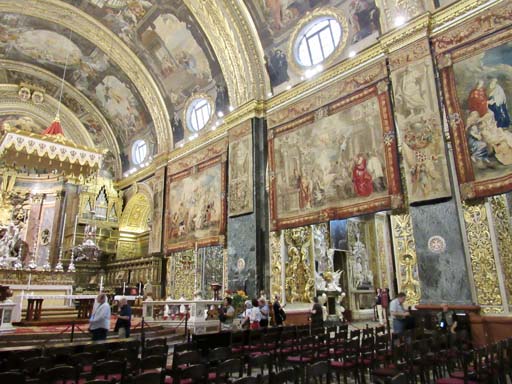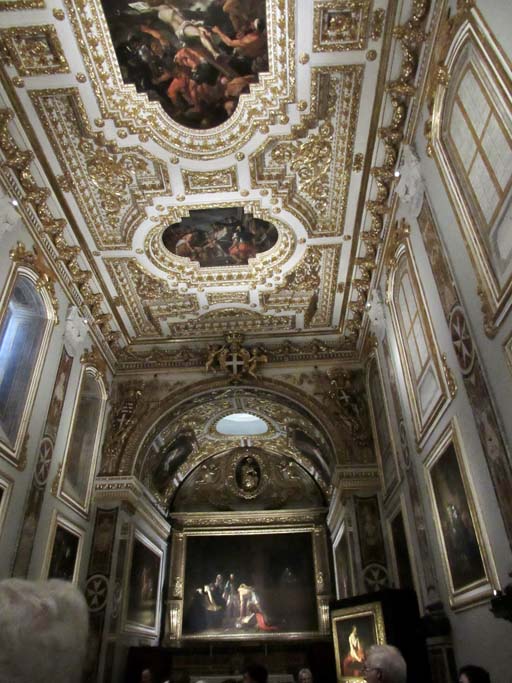A sight of St. John’s cathedral in Valetta is enough to sear the eyes right out of your skull. The style adopted for the interior was Go-For-Baroque, with enough gold, marble, and brilliant color to rival a fever dream of John of Patmos (as opposed to John the Baptist, for whom the cathedral is actually named).
St. John’s is also a co-cathedral, which was a new term for me. When Valetta was built in the late 1500s along with its new cathedral, Malta already had a cathedral in Mdina, the old capital. The rule is that every cathedral gets a bishop, but the Pope wasn’t about to appoint a second bishop for a place as small as Malta, so the eventual solution was that the two cathedrals became co-equals and shared their bishop.
The cathedral was also the home church of the Knights of St John, and when you walk through the building you are literally walking on the graves of hundreds of dead crusader-knights, each laid beneath a large marble slab marked with the knight’s coat-of-arms.
The exterior of the cathedral is far from spectacular, and (like a lot of churches in the region) looks more like a fort than a place of worship. The interior was equally simple until the 1660s, when the Knights’ Grand Master ordered the place spectacularized. Enter statues, gilding, putti, painting, relics, and tapestries!
The tapestries really set the church apart. There are 29 of them, each six meters long, a gift of the then-Grand Master in the early 1700s. (He got a good deal because tapestries were falling out of fashion.) They are the most complete set of tapestries in the world. They’ve undergone a 30-year restoration and are now displayed for the first time since 1991 (it sez right here in the guide).
In one of the side chapels are two paintings by Caravaggio. (I was unable to get a good picture of either.) Caravaggio was a brilliant painter but a violent, unstable, and very stabby character, and found himself on Malta fleeing a murder conviction. (Legend has it he stabbed someone over a game of tennis.) Caravaggio made friends with the current Grand Master and even joined the Order, hoping perhaps for a pardon on the murder charge. He painted three paintings before he took up stabbing again, found himself in the Knights’ prison, and then escaped. (He was expelled from the Order as a “foul and rotten member,” a charge which seems surprisingly personal.) A short while later Caravaggio was dead, probably murdered.
The paintings are The Beheading of John the Baptist and St. Jerome Writing. (The third was a portrait of his patron, the Knights’ Prior.) The Beheading is the only work Caravaggio ever signed, in a trail of blood leading from the saint’s throat. It’s considered a major work in the Western canon, and the other one ain’t hay, either.
I have to say that the Caravaggios put everything else in the shade. All the brilliance and baroque frou-frou are intended to strike if not overwhelm the eye, but Caravaggio’s use of light and shade draws, rather than overwhelms, your attention. No wonder they’re in a side chapel, because they might distract from the onslaught of gilt and color that make up the rest of the building.
After leaving the cathedral I had gelato. Taste was one of the senses the cathedral hadn’t tried to stagger, and I felt I ought not to neglect it.



Caravaggio is an excellent example of the principle that being an artistic genius does not mean that someone is a nice person or even safe to be around.
Comments on this entry are closed.